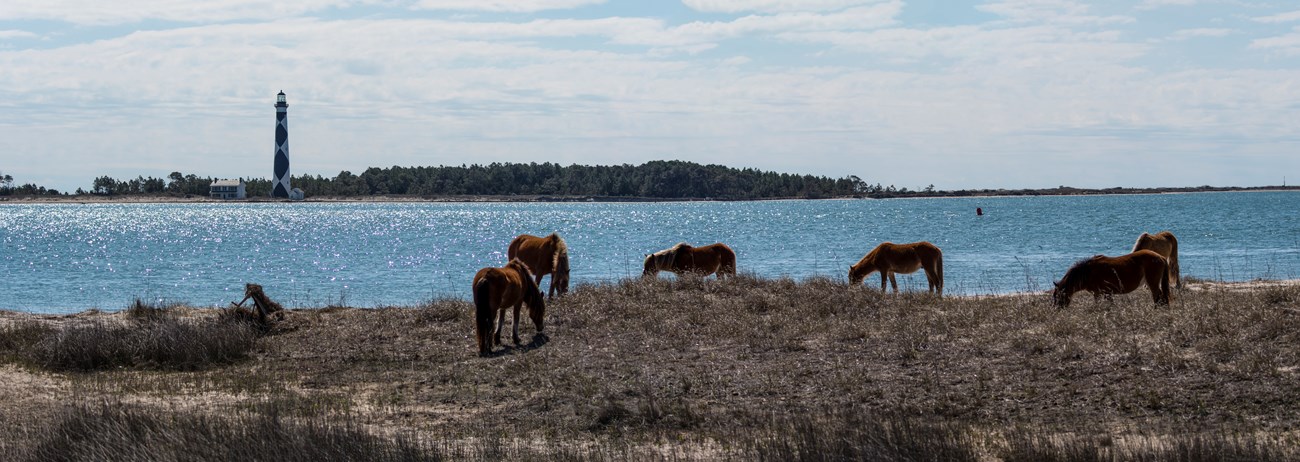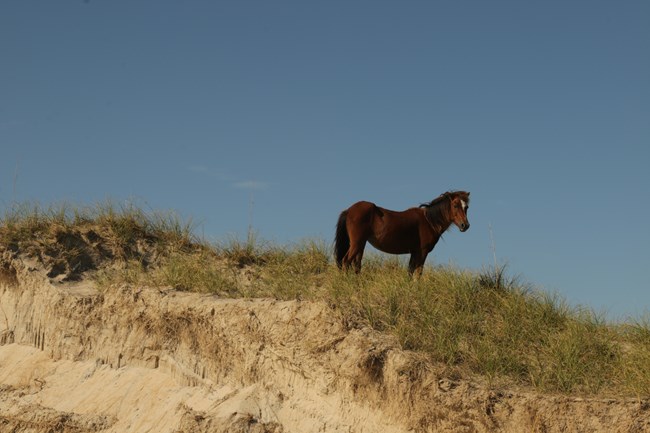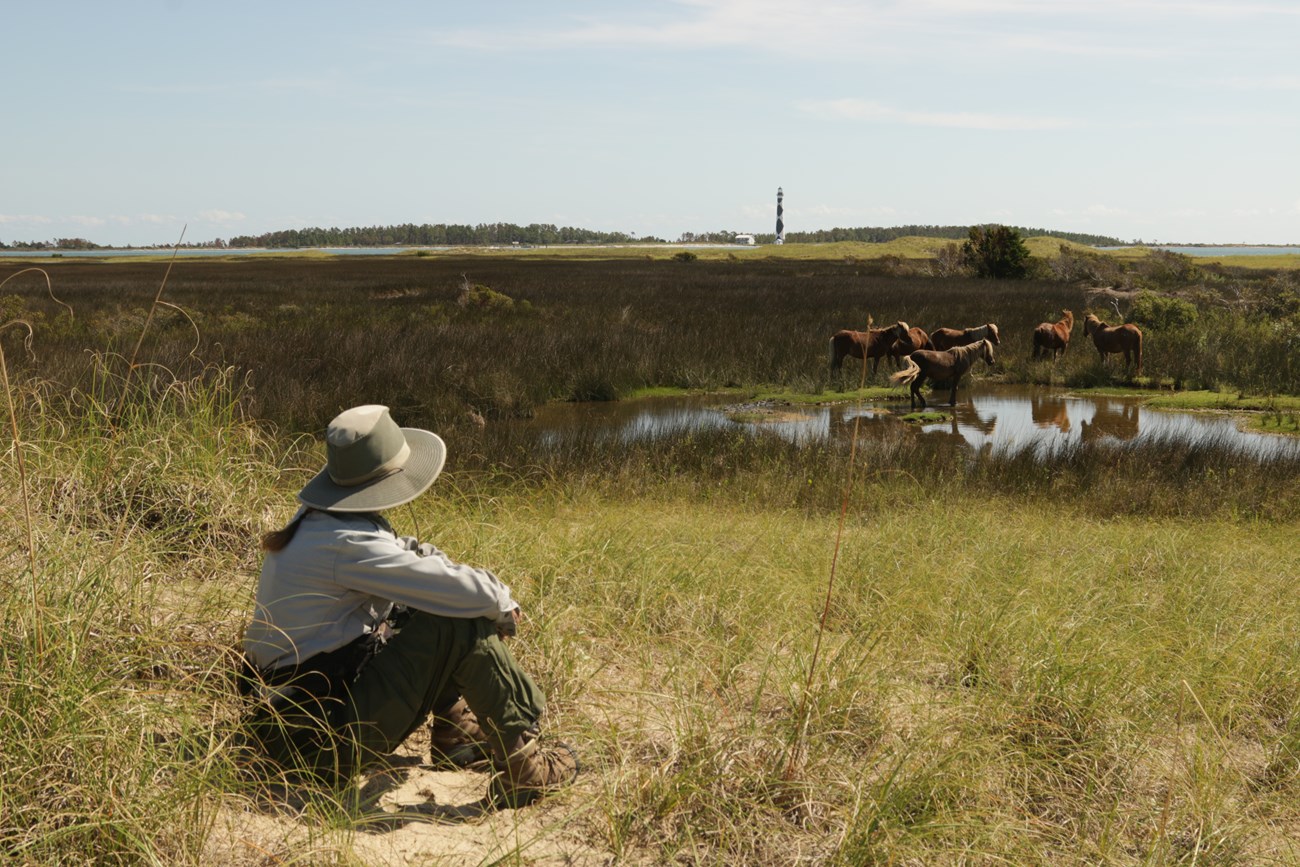
NPS Photo Origins Like the western mustangs, eastern horses were reintroduced to North America by European explorers and settlers. Evidence points to different reintroductions for eastern than the western horses. Records show horses living on the Outer Banks for centuries. Genetic research shows evidence of Spanish ancestry in the Shackleford herd. Shackleford adults average 12 hands in height, with a range of 11 to 13 hands (4” per hand) at the withers (between neck and back). The Banker horses, also called ponies, found up and down the east coast are somewhat related to each other in that they share a similar genetic base and a history of adaption to life on the Outer Banks. 
NPS/Nate Toering The allure of these horses is their wild lifestyle. Every effort is made to keep them wild. They are neither fed nor watered. Natural food sources are present, including Spartina marsh grass and Uniola (sea oats). Fresh water is available in various ponds, pools and digs along the length of the island. In places, the horses dig holes and wait for water to seep up. Protection in storms is afforded by the stretch of rare maritime forest in the west and by the thick shrubs across much of the island.
Safety While it may be tempting to try to approach or feed a wild horse, the animal loses in the end. When a horse must repeatedly move away from people it loses valuable grazing, bonding, nursing, and resting time. When horses frequently experience people too close to them they lose the natural fear that keeps the horses and people safe. Any unusual food, if ingested, can cause serious digestive disorders including death. Horses can inflict serious injuries on people. They bite, may charge, and they can spin to kick amazingly quickly. Wild horses interact with each other in their own language, and an unwary human can accidently be in the path of two fighting stallions or a mare protecting her foal. Federal regulations prohibit “feeding, touching, teasing, frightening or intentionally disturbing of wildlife.” Violators can be fined as much as $5,000 and spend up to six months in jail. Social Life of Wild Horses The herd divides itself into harems and bachelor bands. The number of horses within a harem is subject to change, as stallions frequently spar over mares. Each dominant “alpha” stallion guards a harem containing mares and their young. He directs his harem with “herding” behavior – lowering his head and moving his neck – until the mares and foals move where he wants them. Young horses nurse if they are with their dam (mother), unless they have a younger sibling. At some time, usually between a year and a half and three and half years of age, young colts and fillies leave the harem. The males form loosely associated bachelor bands. Bachelor band life gives colts a chance to spar and mature into stallions who can challenge existing alphas; some day these males will be able to obtain a mare and start their own harem. The females join other harems or are picked up by more experienced bachelors. Within and between harems, a hierarchy is maintained by dominance behavior (pinning the ears back, biting, rearing, striking, and kicking.) The dominant animals have their choice of grazing and water. Often it is a mare who will lead the harem to water. 
NPS/Nate Toering To retain the horses’ wild lifestyle while protecting their island home, some management is necessary. Population growth and mortality are monitored. Selected young horses have been removed during roundups (which are not used anymore). Now, if needed, horses can be removed individually under veterinary sedation. Removed horses may be adopted by the public or donated to other wild herds through the park’s management partner the Foundation for Shackleford Horses, Inc., a non-profit organization. Immunocontraception (birth control) vaccines, effective for one year, are administered in the field without tranquilizers to selected mares. A cadre of experts in genetics, behavior, health and reproduction advise on maintaining genetic diversity, natural social structure and a healthy herd. The island vegetation, including the unique maritime forest, is monitored. Management decisions are made cooperatively by Cape Lookout National Seashore and the Foundation for Shackleford Horses. An annual report is published the beginning of every year. Visitors can view the report on the publication page. Preservation While considered a none-native species by the Park Service because they were re-introduced rather than evolving entirely with their environment, these horses are protected by Federal legislation ensuring their continued presence on Shackleford Banks. The horses are an important part of the history of the area and provide enjoyment for thousands of visitors each year. To learn more about horse watching, and visiting the Shackleford Horses go to the Horse Watching page. |
Last updated: September 24, 2025
